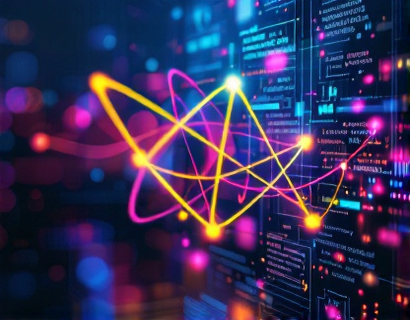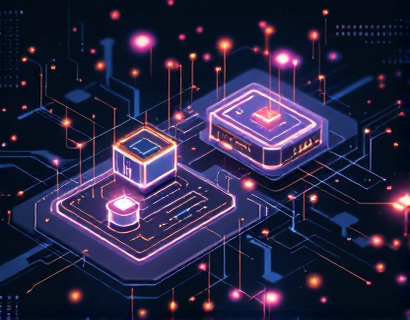Crypto-Enhanced AI: Revolutionizing Digital Engagement for Next-Gen User Experiences
The integration of artificial intelligence (AI) and cryptocurrency is ushering in a new era of digital engagement, transforming how users interact with online platforms and services. This synergy between blockchain technology and machine learning is not only redefining user experiences but also opening up unprecedented opportunities for tech enthusiasts and early adopters. This article explores the transformative power of crypto-enhanced AI, delving into its applications, benefits, and the future landscape it promises.
The foundation of this revolution lies in the unique properties of blockchain technology. Decentralization, transparency, and security are the cornerstones that make blockchain an ideal partner for AI applications. By leveraging blockchain, AI systems can operate with a higher degree of trust and integrity, ensuring that data is immutable and transactions are verifiable. This combination is particularly significant for digital engagement, where user trust and data integrity are paramount.
Enhanced Data Security and Privacy
One of the most compelling aspects of crypto-enhanced AI is the robust security it provides. Traditional AI systems often rely on centralized data storage, making them vulnerable to breaches and data misuse. In contrast, blockchain-based AI solutions store data across a distributed network, reducing the risk of single points of failure. Smart contracts, self-executing contracts with the terms directly written into code, ensure that data access and usage adhere to predefined rules, enhancing privacy and security for users.
For instance, in a crypto-enhanced AI system, user data can be encrypted and stored on the blockchain, accessible only through secure, permission-based protocols. This ensures that sensitive information remains confidential and that users have control over their data. Such measures are crucial in building trust, especially among early adopters who are often more security-conscious.
Improved Personalization and User Experience
AI's strength lies in its ability to analyze vast amounts of data to deliver personalized experiences. When combined with the transparency and decentralization of blockchain, the potential for enhanced personalization becomes even more profound. Crypto-enhanced AI can process user data in a way that respects privacy while still delivering highly tailored content and services.
For example, a digital content platform can use AI to analyze user preferences and behavior, but instead of storing this data centrally, it can be processed through a blockchain network. Users can opt-in to share specific data points, which are then used to curate content without compromising their privacy. This approach not only improves the relevance of the content but also empowers users by giving them more control over their data.
Decentralized AI Marketplaces
The convergence of AI and cryptocurrency has given rise to decentralized AI marketplaces, where developers and users can interact directly without intermediaries. These platforms use blockchain to facilitate the trading of AI models, data, and computational resources. This decentralized approach democratizes access to AI technologies, allowing a broader range of developers to innovate and create value.
In a decentralized AI marketplace, AI models can be tokenized and sold as digital assets, enabling a new economy around AI. Users can purchase, rent, or even trade AI models based on their needs, fostering a dynamic and competitive environment. This not only accelerates innovation but also ensures that users have access to the most advanced AI tools without the need for significant upfront investments.
Tokenization of Digital Assets and Rewards
Cryptocurrency enables the tokenization of digital assets, which can be used to incentivize user engagement and participation. In the context of AI-driven platforms, tokens can serve as rewards for contributing data, participating in AI training, or providing valuable insights. This gamification of user engagement not only enhances user experience but also creates a more active and engaged community.
For instance, a social media platform could introduce a native token that rewards users for creating high-quality content or for engaging with others' posts in meaningful ways. This token can then be used to access premium features, participate in governance decisions, or even traded for other cryptocurrencies. By aligning user incentives with platform goals, such tokenization mechanisms can drive higher levels of engagement and loyalty.
Transparent and Fair AI Governance
The decentralized nature of blockchain also extends to AI governance, ensuring that AI systems are developed and deployed in a transparent and fair manner. Smart contracts can automate the enforcement of ethical guidelines and compliance standards, reducing the risk of biased or harmful AI outcomes. This transparency is crucial for building trust among users, especially in sensitive applications such as healthcare, finance, and education.
For example, an AI system used for credit scoring can have its decision-making process recorded on the blockchain, allowing users to understand and challenge the factors influencing their credit ratings. This level of transparency not only promotes fairness but also empowers users to make informed decisions about their digital footprint.
Scalability and Efficiency
While the integration of AI and cryptocurrency presents numerous benefits, scalability remains a significant challenge. Traditional blockchain networks can struggle with high transaction volumes and slow processing times, which can impact the performance of AI applications. However, advancements in blockchain technology, such as layer 2 solutions and more efficient consensus mechanisms, are addressing these issues.
For instance, sidechains and state channels allow for off-chain transactions, significantly reducing the load on the main blockchain. This enhances the scalability of crypto-enhanced AI systems, enabling them to handle large-scale applications without compromising on performance. As these technologies continue to evolve, the seamless integration of AI and blockchain will become increasingly feasible, paving the way for more sophisticated and efficient digital experiences.
Future Prospects and Challenges
The future of crypto-enhanced AI holds immense potential, with applications spanning various industries. From smart cities and IoT devices to healthcare and education, the combination of AI and blockchain can drive innovation and efficiency. However, several challenges must be addressed to fully realize this potential. These include regulatory hurdles, technical interoperability, and the need for widespread adoption and understanding of these technologies.
Regulatory frameworks need to evolve to accommodate the unique characteristics of crypto-enhanced AI systems. Clear guidelines and standards will be essential to ensure that these technologies are used responsibly and ethically. Additionally, developing interoperable solutions that can seamlessly integrate with existing systems will be crucial for broad adoption.
Education and awareness are also key factors. As these technologies become more complex, it is important to equip users and developers with the knowledge to harness their full potential. Initiatives that promote learning and collaboration can help bridge the gap between tech enthusiasts and the broader population, fostering a more inclusive digital ecosystem.
In conclusion, the integration of AI and cryptocurrency is revolutionizing digital engagement, offering enhanced security, personalization, and transparency. As these technologies continue to mature, they will play a pivotal role in shaping the next generation of user experiences. For tech enthusiasts and early adopters, the possibilities are endless, and the journey ahead promises to be both exciting and transformative.











































